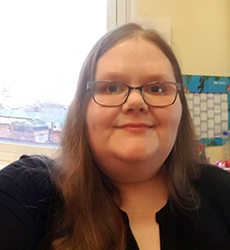Dr Samantha Irving
What is your job title?
I am a Chief Paediatric Respiratory Research Physiologist (clinical scientist), and a Clinical Lecturer at NIHR (National Institute for Health Research).
Which NHS and academic institutions do you work for?
I work at the Royal Brompton and Harefield NHS Foundation Trust and the Imperial College London.
What do you like about being a clinical academic?
I like the variety. No two days are entirely the same, and having both research and clinical roles lets me get involved with a variety of projects in several different environments. I like that one day I could be performing lung function testing with a paediatric patient and their family, and the next I can be crunching statistics for a publication or teaching physiology to students.
Can you briefly describe how you became and developed as a clinical academic?
I knew I was in a very research active department, and when an unusual result turned up in routine clinical testing I was encouraged to look further in to it. That result turned into a research project, and that turned into a PhD. Then a swore I was keen to get back into a clinical role and leave the research alone for a bit, but within a few months I was bored. I’d gotten the research bug and knew I had to do more! I didn’t want to leave my clinical role entirely though, so I started looking for ways to develop as a clinical academic.
Since then I’ve been lucky enough to have received a few grants that let me continue working on my research and develop my clinical academic skills, and then an HEE/NIHR ICA fellowship in 2018 that supported my research for three years and offered more training and development opportunities.
Give one example of where your work has changed practice?
A lot of my work has been in Primary Ciliary Dyskinesia, a rare condition in which structurally or functionally abnormal cilia cause a range of symptoms, including lung disease. Large airway disease is fairly easy to monitor, whereas earlier changes that affect the small airways are notoriously difficult to detect and quantify. Through my work, we’ve been able to show that children with PCD can have small airway disease, and evaluate which tests can accurately measure it, allowing better clinical monitoring in these patients.
What advice would you give to a healthcare scientist who is an aspiring clinical academic?
Get good people around you. Research can be lonely, and combining the expectations of a mixed research/clinical role can be challenging. Supportive colleagues – both junior, senior, and peers – make everything a lot easier. If you don’t have that support in your immediate team, look a bit further afield, and find out what research is going on around you in your wider unit or hospital. I was pleasantly surprised how almost everyone I contacted about their research was happy to talk to me about their work and offer advice on mine. That grounding gave me extra insight when trying to develop my clinical academic role.
And persevere! The clinical academic route is relatively new in healthcare science, and you will come across frustrations, rejections and setbacks, sometimes just because you’re trying to do something that hasn’t been done before. Pick yourself up, dust yourself off, and get ready to try again.
